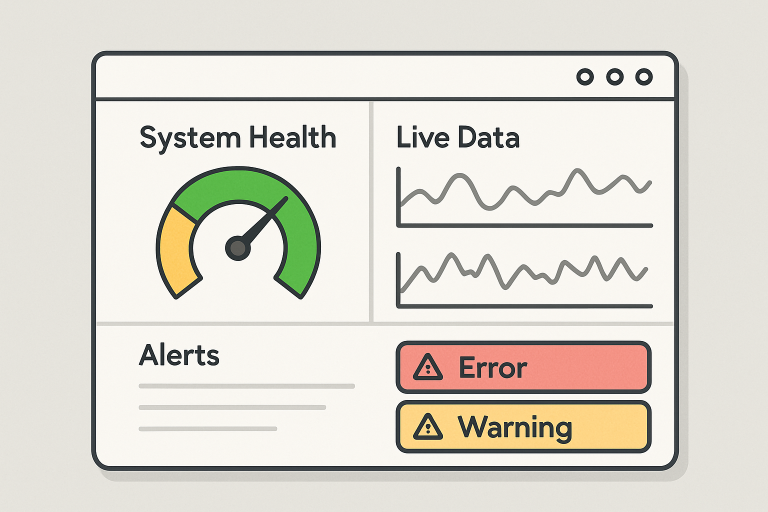Table of Contents
- Introduction
- Understanding Real-Time Application Monitoring
- Enhancing Operational Efficiency
- Improving Customer Experience
- Facilitating Proactive Maintenance
- Supporting Data-Driven Decision Making
- Challenges in Implementation
- Future Trends in Real-Time Monitoring
- Conclusion
Introduction
In the ever-evolving digital world, rapid innovation and continual system optimization are vital for organizations aiming to stay ahead of the competition. One of the most effective strategies for achieving this is application performance monitoring, empowering businesses to diagnose and address issues when they arise. By providing ongoing visibility into system health and user activity, real-time monitoring enables IT and business leaders to make proactive, data-driven decisions.
As more businesses transform their operations to become digital-first, leveraging real-time insights has become essential. Modern enterprises rely on these technologies to avoid critical failures and drive continuous improvement of their user experience and operational workflows. Whether identifying bottlenecks or keeping crucial systems running smoothly, application performance monitoring gives teams the agility and awareness necessary to excel.
Understanding Real-Time Application Monitoring
Real-time application monitoring is the continuous process of tracking the health and performance of software systems as they run. Instead of relying solely on periodic reviews or historical data, these systems capture live metrics such as server response times, transaction throughput, error rates, and user behavior, offering immediate feedback and alerting teams to anomalies the moment they occur. According to CIO, businesses utilizing real-time monitoring can react to problems faster and ensure greater system availability.
Organizations can achieve granular insight into intricate operational issues using sophisticated data collection tools and dashboards. Such visibility ensures that IT departments and business leaders have a shared understanding of system status, supporting alignment across technology and business goals.

Enhancing Operational Efficiency
Optimizing workflows and minimizing disruptions is critical for any business striving to maximize output. Real-time data monitoring provides a comprehensive overview of operational health, empowering teams to quickly identify performance drops or inefficiencies and respond before services are affected. Research suggests that businesses leveraging live data make decisions up to 5x faster than those relying on delayed reporting.
Visual dashboards and automated alerts highlight areas requiring real-time attention, which is especially valuable for complex enterprise environments with numerous moving parts. Visualizing live operational data can also uncover new optimization opportunities, fostering a culture of ongoing improvement.
Improving Customer Experience
Customer satisfaction often hinges on seamless digital experiences through web platforms, mobile apps, or services. Real-time monitoring means teams can detect and resolve customer-facing issues—sometimes before the customer notices them. This level of responsiveness directly impacts customer loyalty and brand reputation.
For example, e-commerce retailers use live monitoring tools to track load times, error reports, and transaction speeds to ensure frictionless purchasing. Real-time insights in sectors like banking and healthcare help maintain vital service continuity, leading to higher user trust levels. As Forbes highlighted, timely data delivery shapes memorable customer journeys.
Facilitating Proactive Maintenance
Continuous monitoring allows for a shift from reactive to proactive maintenance strategies. Rather than waiting for outages or slowdowns, predictive analytics within real-time monitoring platforms enable teams to spot warning signs of system fatigue or impending failures. This is especially crucial in industries reliant on costly hardware or 24/7 services, where downtime can result in substantial financial loss.
By leveraging data trends and automated diagnostics, organizations can schedule repairs or upgrades at optimal times, minimizing disruption and extending the life of key assets. Proactive maintenance lowers overall costs and ensures that mission-critical services remain available and efficient.
Supporting Data-Driven Decision Making
Empowered with live operational metrics, decision-makers can shift their approach from hindsight to foresight. Real-time reporting provides an instant feedback loop highlighting emerging trends or problems, enabling business leaders to take corrective action before minor glitches escalate into major disruptions. This agility supports innovation and positions organizations to outperform less responsive competitors.
Beyond troubleshooting, real-time insights drive strategic change, guiding product enhancements, shaping customer strategies, and informing high-level business decisions. Organizations that act on consistent, reliable live data report greater efficiency, lower risk, and enhanced profitability.
Challenges in Implementation
Despite clear benefits, setting up robust real-time application monitoring presents challenges. The influx of continuous data can strain IT infrastructure, necessitating investments in scalable storage and processing power. Additionally, integrating modern monitoring tools with legacy systems can be complex and require rethinking existing workflows.
Implementing these systems may also introduce security and compliance considerations, especially when sensitive information is involved. As recent trends in enterprise IT adoption have outlined, overcoming these hurdles involves careful planning, the right mix of technology partners, and continuous assessment of evolving business requirements.
Future Trends in Real-Time Monitoring
As technology advances, the role of artificial intelligence (AI) and machine learning in application monitoring will become increasingly prominent. These innovations will automate analysis and response, allowing monitoring systems to detect and alert, predict problems, and take corrective action without human intervention. This shift will foster even greater reliability and efficiency across industries.
Adaptive, intelligent monitoring solutions are expected to become a standard feature of the digital business landscape, supporting everything from IT operations to customer engagement strategies.
Conclusion
Real-time application monitoring has become a cornerstone of modern digital transformation, a powerful tool for organizations navigating fast-paced business environments. Delivering immediate, actionable insights allows companies to swiftly detect performance issues, anticipate potential disruptions, and optimize system efficiency. This level of responsiveness enhances operational agility, helping teams adapt to changing demands without delays. Beyond technical performance, effective monitoring directly improves customer experiences by ensuring seamless service delivery, reduced downtime, and consistent reliability. While implementation may present challenges such as integration complexities or resource allocation, overcoming these hurdles is essential. As automation, AI, and predictive analytics innovations emerge, businesses that embrace real-time monitoring will secure greater resilience, efficiency, and a lasting competitive advantage in dynamic markets.
READ ALSO: The Importance of Efficient Data Migration Services in the Modern Era

